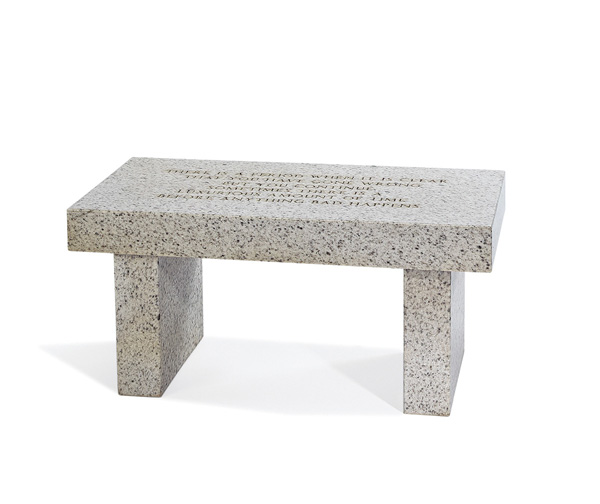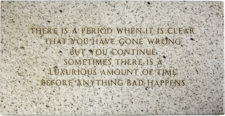
Jenny Holzer
American, 1950
The Living Series: There is a period when it is clear…, 1989
Bethel white granite bench, from the edition of 3 and 1 artist's proof
17 x 36 x 18 in.
SBMA, Gift of Laura-Lee W. Woods TR 3647
2017.20

Holzer sitting on a bench in 1991, portrait by Barbara Yoshida.
“My legacy from growing up in the 60’s is that I want to make art that’s understandable, has some relevance and importance to almost anyone. And once I’ve made the stuff, the idea is to get it out to the people. I want them to encounter it in different ways, find it on the street, in electric signs and so forth.” (New York Times, 1989)
“I make benches when I want to find a certain way to bring text and people together. Passersby might walk to a bench to sit, and before they sit, they often read. I like how people read text in stone, and I like the associations of writing in stone.” (Vassar College interview).
"Where a bench is positioned, or where any public art is displayed, can easily engage and challenge the viewer to consider a myriad of personal and private thoughts." - Jenny Holzer
RESEARCH PAPER
This gleaming 2-seat bench is fabricated from speckled grey and white Vermont granite, highly polished, and refreshingly cool to the touch with strong straight recessed legs. The smooth marble glows and is an invitation to the viewer to sit, rest, and think. Sandblasted onto the top are the words:
THERE IS A PERIOD WHEN IT IS CLEAR
THAT YOU HAVE GONE WRONG
BUT YOU CONTINUE
SOMETIMES THERE IS A LUXURIOUS AMOUNT OF TIME
BEFORE ANYTHING BAD HAPPENS
THERE IS A PERIOD WHEN IT IS CLEAR THAT YOU HAVE GONE WRONG.
Just as the act of sitting on a bench invites contemplation, this phrase starts the viewer on a journey of reflection on their past occurrences, perhaps a life event, perhaps a catastrophe, or a misguided act. BUT YOU CONTINUE. Holzer suggests that moving forward is the strongest personal action, and then posits: SOMETIMES THERE IS A LUXURIOUS AMOUNT OF TIME BEFORE ANYTHING BAD HAPPENS. Thus, by letting go of the pressures of time one can achieve calmness and inner serenity. Holzer’s bench encourages an overall, positive reinforcement of the power of faith, or luck, to mediate a foreboding occurrence. There’s also positivity; a sense of hope for the future. There’s the ability to reach a state of peacefulness to meet the next challenge in life.
Jenny Holzer’s Living Series bench is best appreciated in the context of the Public Art that became prolific in the 1980s. The new ‘art gallery’ experience moved to exterior landscapes. Public spaces, outdoor architecture, and edifices were appropriated to share art with a mass audience.
In 1976, Holzer was selected to participate in The Whitney Museum’s Independent Study Program, a program of intellectual discourse and artistic pursuits. Delving into Western and Eastern readings fueled her desire to make these philosophies more accessible to a broader audience. Holzer reproduced her original text as installations. She is often referred to as a pioneer in the Pictures Generation for the use and display of thought-provoking and strong phrases, known as ‘aphorisms or truisms.’ The artists of the Pictures Generation were looking for new ways to make narrative or commentary an integral part of visual objects. Holzer’s unique text-based artwork is a bold expression of how words and language can be manipulated. Her public projects, site-specific installations and institutional commissions, often constructed as a series, promote personal discourse and commentary on social and political issues as well as the global condition. To Jenny Holzer, the absolute purpose of public artworks is to be widely accessible and is her deliberate means to engage, in a thought-provoking way, with the viewer.
Holzer’s artistic voice, and range ofopinions as text, is captured in and projected onto multiple, and often non-traditional, mediums that include massive LED light installations, billboards, large scale projections on building facades, video, t-shirts and caps, and granite benches. Most notable of these installations, sponsored by New York’s Public Art Fund (1982), was the huge Times Square signboard with flashing red and white lights presenting random ‘truisms.’ A sample of Jenny Holzer’s truisms includes PROTECT ME FROM WHAT I WANT, REMEMBER TO REACT, SIGN OF IMMATURITY, IT IS MAN’S FATE TO OUTSMART HIMSELF, ABUSE OF POWER COMES AS NO SURPRISE. Holzer’s artwork appropriated the images and language of mass media in order to examine its assumptions (The Art Story).
Jenny Holzer, born in 1950 in Gallipolis, Ohio, was reared amid traditional, Midwestern ‘common sense’ values. As a young woman, Holzer’s artistic direction was confined to large scale abstract paintings. Language fascinated her because it could communicate in a way painting could not (YouTube). However, Holzer chafed at the requisite collegiate fine arts courses (Duke University, University of Chicago, Ohio University) and it wasn’t until graduate studies at Rhode Island School of Design that she began to deeply engage with the political momentum of the late 60’s early 70’s. Holzer’s generation was over-saturated with the mass media imagery of television. Advertising commercials, logos and slogans, billboards - these were the backdrop against which artists chose to express their discontent with the status quo and redefine their world. The volatile social fabric of the era was Holzer’s palette to artistically express her opinions, overall political discontent, and radical discourse about feminism, anti-Vietnam War protest, and the AIDS epidemic.
Jenny Holzer chose thought-provoking truth-seeking messaging, and her break-out large scale public art projects encourage the dialog of self-awareness, personal identity, and a voice for change. For Holzer, the text-based image, reminiscent of graffiti, is the art, unlike artwork that also incorporates text messages.
The award-winning flashing LED signs at the 1990 Venice Biennale, numerous commissions and permanent installations at established art institutions such as MOMA, MASS MoCA, Dia Art Foundation, and Tate London speak of Jenny Holzer’s prominence in the contemporary art world.
Prepared for the Santa Barbara Museum of Art Docent Council by Sara Bangster
January 2018
Bibliography
Art21 (March 8, 2009). Television series. Projection for Chicago, Jenny Holzer. www.art21.org.
The Art Story. The Pictures Generation, “re-presentation, not representation.”
The Broad (2018). Los Angeles, CA. Jenny Holzer. In the collection statement.
Glueck, Grace (December 3, 1989). The New York Times: And Now, a Few Words From Jenny Holzer.
Los Angeles Modern Auctions (March 15, 2017). Los Angeles, CA. Jenny Holzer The Living Series: There is a period when it is clear… Lot 37 description.
Mac, Jack (2016). YouTube: Composing the Real. Video documentary on Jenny Holzer. www.youtube.com/watch?v=Y74WGcc084M.
MASS MoCA (2018). North Adams, MA. Jenny Holzer at MASS MoCA viewing statement.
Molesworth, Helen (2012). Museum of Contemporary Art, Chicago, IL. This will have been: Art, Love, & Politics in the 1980s. Exhibition publication. Pages 193-196.
Museum of Modern Art (2017). New York, NY. Jenny Holzer artist statement.
Public Art Fund (1982, 1984, 1988, 1989, 2012). New York, NY. Jenny Holzer Exhibition Schedule.
Skarstedt Gallery (2010). New York, NY. Jenny Holzer Retro. Exhibition introduction.
TimeOut NEWYORK (September 8, 2014). New York, NY. Lack of content is the message: interview with Jenny Holzer.
Walker Art Center (2018). Minneapolis, MN. Art and Artists: Jenny Holzer.
Whitney Museum of American Art (2009). New York, NY. Jenny Holzer: Protect Protect.
Vassar College(2017). Poughkeepsie, NY. The Frances Lehman Loeb Art Center: 2006 Interview with Jenny Holzer.
POSTSCRIPT
This bench can be touched and viewers may sit on it.

There is a period when it is clear that you have gone wrong but you continue. Sometimes there is a luxurious amount of time before anything bad happens.
COMMENTS
The work of Jenny Holzer is among the most recognizable today. Famed for her use of enigmatic phrases and powerful aphorisms, known as ‘truisms,’ her text–based work encompasses sculpture, painting, film, light installation, and photography. Holzer is often described as one of the Pictures Generation, alongside artists like Cindy Sherman, Louise Lawler, and Barbara Kruger, who rose to prominence in the late 1970s and 1980s. This term was coined by art historian Douglas Crimp to characterize artworks that appropriated the imagery and language of mass media in order to examine its assumptions.
Holzer was born in 1955 in Gallipolis, Ohio. She spent several years taking courses in art at institutions such as Ohio University, the University of Chicago, Duke University, and Rhode Island School of Design. It was during her time in the Whitney Independent Study Program in 1976 that her unique voice took form. There she began her first experiments with text and site-specific installations in public locations. As she became more established, she went on to create public projects of monumental proportions, including the vast LED light installation of the billboard Protect Me From What I Want (1982) in New York Times Square or the memorable For the City (2005), which was projected across the facade of the New York Public Library.
While these installations were met with great success, Holzer continued to test different scales and alternative media. The Living Series: There is a period when it is clear… (1989) emerged during the decade in which the artist began working with marble and stone in response to a series of institutional commissions. The text on the bench is carved in the United States Department of War typeface, also called ‘Government style’ font. This was designed in the 1930s for the Veterans’ Administration headstones and markers in use today. The form of the engraved bench is commemorative, yet its words invoke both a sense of threat and potential. Holzer warns of a future in which things may go awry without corrective action, and challenges the viewer to consider their own position in deeply critical terms. The importance of this message is underscored by the sculpture’s weighty materials and the font’s official origins, with its associations of gravitas and permanence.
In an interview Holzer explained the intention behind these works, “It’s almost impossible to shock an art audience. There may be a greater chance with the outdoor work that you might startle people so much that you have some hope of changing their thinking a little bit, or even prompting them to take some kind of action. You might have an incrementally better chance of altering something in the world with the public stuff just because you reach more people, and because the content of the writing is taken at face value, it is not dismissed as art.” This stately, austere piece relates to her site-specific sculptures for Dia: Chelsea, New York and the Walker Sculpture Garden, both executed in 1989.
- Waldman, Diane. “Interview: Jenny Holzer and Diane Waldman.” Jenny Holzer. New York: Solomon R. Guggenheim Museum, 1989.
SBMA CURATORIAL LABELS
Jenny Holzer, a feminist whose art draws on the conventions of commercial advertising, is well-known for her “truisms.” These are canny observations about life that appear on billboards, shopping bags, t-shirts and, for a period, in New York’s Times Square. This work elliptically warns about impending danger. Moreover, granite commonly marks graves, adding to the menacing tone.
- Contemporary Gallery Opening, 2021
